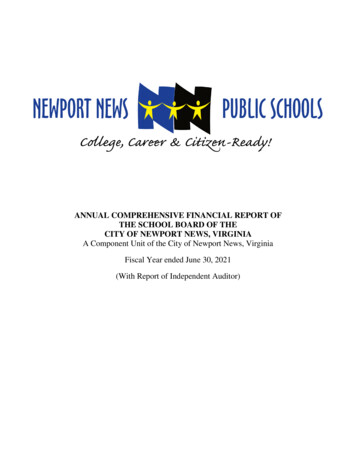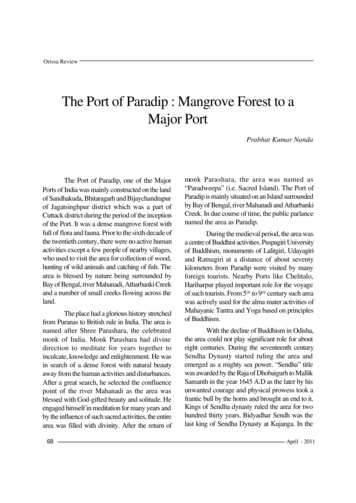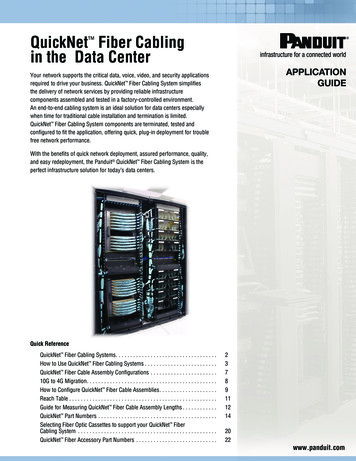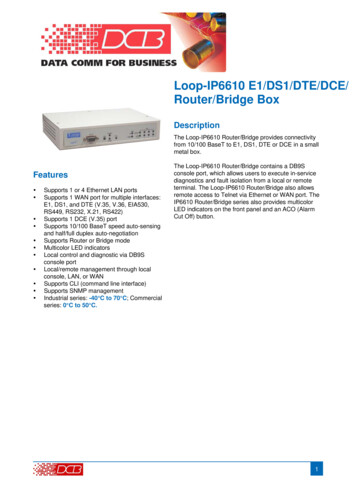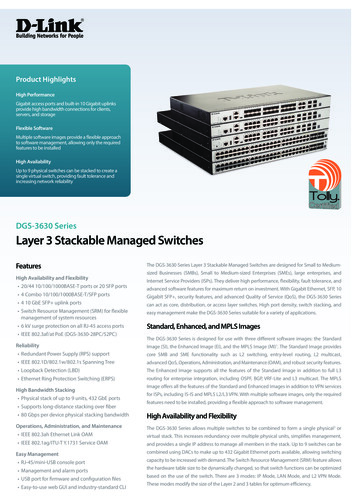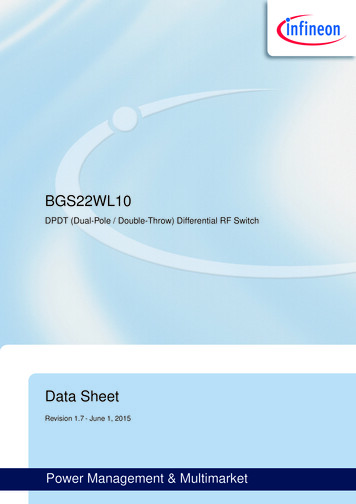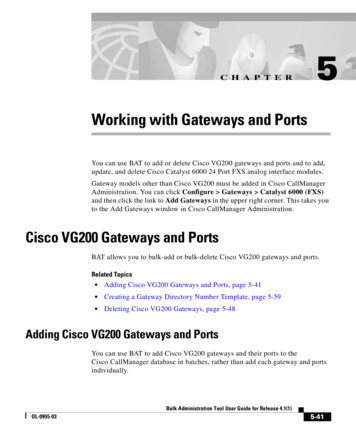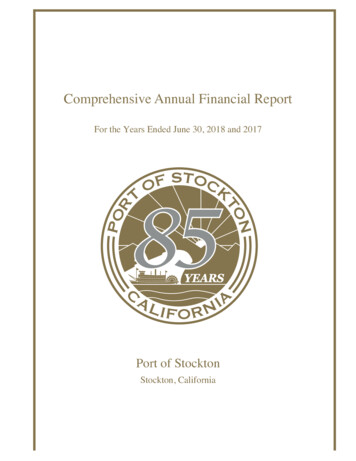
Transcription
Comprehensive Annual Financial ReportFor the Years Ended June 30, 2018 and 2017Port of StocktonStockton, California
Comprehensive Annual Financial ReportFor the Years Ended June 30, 2018 and 2017Port of StocktonP.O. Box 2089Stockton, CA 95201Prepared byThe Finance and Administration Department
Stockton Port DistrictComprehensive Annual Financial ReportTable of ContentsFor the Year Ended June 30, 2018Introductory Section (unaudited):Letter of Transmittal . iGFOA Certificate of Achievement for Excellence in Financial Reporting . vList of Principal Officers . viOrganization Chart . viiAerial View of the East and West Complex . viiiFinancial Section:Independent Auditors’ Report . 1Management’s Discussion and Analysis (unaudited Required Supplementary Information) . 3Basic Financial Statements:Statement of Net Position . 12Statement of Revenues, Expenses, and Changes in Net Position . 13Statement of Cash Flows . 14Notes to Financial Statements . 16Required Supplementary Information (unaudited)Schedule of Changes in the Total OPEB Liability and Related Ratios . 39Supplementary InformationOutstanding Construction in Progress Detail . 40Statistical Section (unaudited):Summary of Revenues, Expenses, and Changes in Net Position - 10 years . 42Net Position by Component - 10 years . 44Principal Customers - 2018 . 46Summary of Revenues and Revenue Tonnage Trends - 10 years . 47Computation of Legal Debt Margin - 10 years. 49Ratios of Outstanding Debt by Type - 10 years . 51Revenue Bond Coverage - 10 years . 52Demographic Statistics - 10 years . 53Port of Stockton Employees by Department - 10 years. 54Port of Stockton Capital Assets by Asset Type - 10 years . 55Ten Year Trend in Waterborne Tonnages for California Ports . 56Revenue Tonnages - 10 years . 57Waterborne Tonnage Trends for Ports in California (2018, 2017, and 2009) . 59
Port of StocktonStockton, CaliforniaIntroductory SectionIntroductory Section
P ORT OF S TOCKTONPhone: (209) 946‐0246Fax: (209) 465‐7244December 17, 2018Mr. Richard AschierisPort DirectorStockton Port DistrictP.O. Box 2089Stockton, CA 95201To Mr. Aschieris, Port Director, Port Commissioners, and Citizens of the Port District:The Comprehensive Annual Financial Report for the Stockton Port District (District), for the years endedJune 30, 2018 and 2017, as prepared by the Finance Department is hereby submitted for your review.Responsibility for both the accuracy of the presented data, the completeness and fairness of the presentation,including all disclosures, rests with the District’s management. To the best of our knowledge and belief theenclosed data is accurate in all material respects and is reported in a manner designed to fairly present thefinancial position and changes in the financial position of the District. All disclosures necessary to enablethe reader to gain an understanding of the District’s financial activities have been included. Although theDistrict is not legally required to prepare the Comprehensive Annual Financial Report, we do so to aidfinancial institutions and our community in their understanding of the District’s activities and its financialcomposition. The Management’s Discussion & Analysis, in the financial section, will give readers aninformative overview of District operations for the last year. To provide reasonable assurance that thefinancial statements are accurate, management has established an internal control framework to compiledata for the preparation of the financial statements and to protect the District from fraud, misuse or loss. Aswith any system, the inherent limitations of the system make it essential that the District review thisstructure when opportunities are presented but the cost of a control should not exceed the benefits to bederived. The objective of internal controls is to provide reasonable, rather than absolute assurances, that thefinancial statements are free of any material misstatements. The District’s internal controls include built-inchecks and balances for purchasing and billing, contract approval and routine reporting and reconciliationprocedures for accounts. To management’s knowledge, this financial report is complete, accurate andreliable in all material respect.The District is a self-supporting special district of the State of California. Its entire operations are accountedfor on an accrual basis in a single proprietary enterprise fund and receives no tax dollars. The District hasa comprehensive methodology of internal controls that encompasses the whole accounting process and itsprocedures to assure the most accurate distribution of its financial data. The financial audit was completedby independent auditors, Vavrinek, Trine, Day & Co., LLP. The auditors provide reasonable assurance thatthe financial data is fairly stated and also review the accounting system and procedures.Post Office Box 2089 Stockton, CA 95201‐2089 E‐mail: portmail@stocktonport.comAdministration Office: 2201 West Washington Street Stockton, CA 95203 Web Page: www.portofstockton.comi
Government ProfileThe District was established under the California Harbors and Navigation Code, Sections 6200 through6372. It is governed by a seven-member Board of Commissioners (Board). Four commissioners areappointed by the Stockton City Council and three by the San Joaquin County Board of Supervisors. Theday-to-day administration of District operations is under the direction of the Port Director who is selectedby and serves at the will of the Board. A current organization chart of the District is included in this report.The District’s geographical boundaries are the same as the City of Stockton’s, with the exception of aneight-mile long strip extending one-half mile on either side of the Stockton Ship Channel.The District is a deep-water seaport located seventy-five miles inland from San Francisco, in the agriculturalheartland of California in San Joaquin County. The District owns and operates docks, transit sheds, andwarehouses which are used to load and unload cargo from ships, barges, trucks, and railroads, and to storecargos. Cargos handled by the District include various dry and liquid bulk commodities, general cargos,and project cargos. Some of the commodities handled at the District include steel products, rice, cementand slag, sulfur, gypsum, fertilizers, molasses, coal, edible oils, and ammonia. The District also leases landand warehousing facilities to a number of diverse tenants. District operations are self-supporting and receiveno direct tax subsidies.Budget StructureThe Board of Commissioners adopts a budget for each fiscal year. The District uses an informal system ofbudgetary accounting and control. The budgetary estimates are retained in memorandum form and used forcomparative purposes only. As part of the budget presentation, the District utilizes a five-year forecast forcapital projects to improve long range planning.Economic ConditionLocal EconomyThe San Joaquin County (County) economic activity over the past several years had slowed with the declinein the construction and housing industry, but this year most sector indicators have started to show positivetrends except the federal government sector. The County has a population of approximately 743,900 people,which is expected to grow 1.4% in 2018. The Employment Development Department of California statesthat the County has a labor force of 327,400 with a current unemployment rate of 6.0%. The EberhardtSchool of Business Forecasting Center at the University of the Pacific (UOP) is predicting thatunemployment will continue to range between 5.9% and 5.5% through 2020. UOP is anticipating jobgrowth in professional and business services; the construction and mining sectors; and financial activitiessectors with decreasing job numbers in the leisure and hospitality and other services sectors. The personalincome growth is expected to increase at a rate of 5.7% for 2019.San Joaquin County is one of the largest agricultural producers in the State. The total area in the county is1,391 square miles with 517,918 acres of farmland in 2017. The gross value from the county’s agriculturalproducts in 2017 was approximately 2.5 billion, an increase of 8.1% from 2016. The agriculturalproduction in the county is the byproduct of a fertile land and temperate weather conditions. The County’stop six leading crops are grapes, milk, almonds, walnuts, cherries, and cattle.The County does enjoy a highly educated workforce, with many coming from the local colleges in the area.The University of the Pacific, California State University, Stanislaus-Stockton Center, Humphreys Collegeand Humphreys School of Law, National University and San Joaquin Delta Community College all offer awide choice of educational opportunities within the community. There are also many adult educationalprograms available throughout the 15 school districts in the County.ii
The District plays an important role in providing local industry and shipper’s access to the internationalexport and import marketplace. Through the District’s facilities, local products are shipped botheconomically and efficiently. Our modern facilities are designed to enhance the shipment of break bulk,general cargoes and bulk cargoes, such as steel products, rice, bulk cement, coal, fertilizers and liquidproducts. The District operates within Foreign Trade Zone #231 and offers its customer the flexibility andadvantages of operating within those regulations.Long-term Financial PlanningThe District is a public entity that functions similar to a self-supporting business. Our long-term planningand financial goals are tied to our customer base and the needs of future customers/tenants. With theconveyance of the adjacent Rough & Ready Island Naval Base in 2000, the District started a developmentprogram for infrastructure improvements that includes the Port of Stockton Expressway Bridge, expandedrail infrastructure, dredging the docks and other amenities for customer usability. Any new developmentsor improvements will be customer driven as they expand their operations or as new businesses come to theDistrict. The District refunded the 1997 bonds and issued 29.7 million in new bonds in 2007. In 2013, theDistrict refunded the 2001 Bonds with an installment loan with Compass Bank and secured capital leasesfor equipment for the terminal and warehouse operations. The District secured an 8.2 million loan for railinfrastructure improvements in fiscal year 2016. In fiscal year 2017, the District refunded the 2007 seriesA (tax-exempt) Bonds and the I-Bank loan while issuing an additional 5 million in bonded debt forinfrastructure projects. The District has a total of 44.2 million in outstanding bonds, loans and capital leaseobligations. The bonds and installment loans are secured by and payable from gross revenues derived fromthe operations of District facilities. The proceeds of these issues were used for capital improvements andrefunding certain outstanding bond issues. The District has no general obligation bonds. The details of ourdebt structure can be reviewed in the Management’s Discussion and Analysis and the Notes to the FinancialStatements.Relevant Financial PoliciesThe Board has established financial policies that affected the financial position in the current year and giveguidelines on cash management and investments, purchasing, and capital expenditures that are followed bythe management staff. Through the budget process each year, the Board reviews and approves the District’sfinancial projections, goals, and business trends. In the budget, there is also a five-year forecast for capitalimprovements and new projects that present our future objectives. For all financial reporting and accountingprocedures, the District uses the Governmental Accounting Standards Board (GASB) guidelines as ourstandard.Major InitiativesThe District utilized 14.9 million this year in grant funds for infrastructure improvements, which includedthe homeland security projects, dredging, and the Navy Drive Bridge and widening project. These capitalprojects were funded by federal and state grants. All of these improvements have added value to the Districtand the community in terms of business opportunities and new jobs.Awards & AcknowledgementsThe Government Finance Officers Association of the United States and Canada (GFOA) awarded aCertificate of Achievement for Excellence in Financial Reporting to the Stockton Port District, for itscomprehensive annual financial report for the fiscal year ended June 30, 2017. This was the eighteenthconsecutive year that the Stockton Port District has achieved this prestigious award. In order to be awardeda Certificate of Achievement, a government unit must publish an easily readable and efficiently organizedcomprehensive annual financial report. This report must satisfy both generally accepted accountingiii
iv
Back:Gary Christopherson,Commissioner;Sylvester C. Aguilar,Chairman;Stephen Griffen,Vice ChairmanMichael Patrick Duffy,CommissionerFront:R. Jay Allen,Commissioner;Victor Mow,Commissioner;Elizabeth Blanchard,Commissioner;Richard Aschieris,Port Director.Board of CommissionersSylvester C. AguilarChairmanStephen GriffenVice ChairmanR. Jay AllenCommissionerElisabeth BlanchardCommissionerGary ChristophersonCommissionerMichael Patrick DuffyCommissionerVictor MowCommissionerPort StaffRichard AschierisPort DirectorSteve CookerlyMaintenance SuperintendentSteven EscobarDeputy Port Director ofReal Estate & Port DevelopmentPete GrossgartMarketing ManagerDianna L. BakerDirector of FinanceJason KatindoyDirector of Maritime OperationsGeorge LernerDirector of Homeland SecurityJeff WingfieldDirector of Environmental &Regulatory AffairsMichelle R. BowlingController/Internal AuditManagerDebbie CalliProperties ManagerJason CashmanEnvironmental & RegulatoryAffairs ManagerviKatie MillerHuman Resources ManagerChris MountjoyOperations ManagerRicardo NavarroMaintenance SuperintendentRuss NicholasTelecomm ManagerMelanie RodriguezAssistant to the Director/Secretary to the BoardRick SalsedoPolice CaptainJuan VillanuevaDevelopment & PlanningManager/ DBELO Manager
vii
EASTCOMPLEXviii
WESTCOMPLEXix
This page intentionally left blank.
Financial SectionFinancial SectionPort of StocktonStockton, California
INDEPENDENT AUDITORS’ REPORTTo the Board of CommissionersStockton Port DistrictStockton, CaliforniaReport on the Financial StatementsWe have audited the accompanying financial statements of the Stockton Port District (District) as of and for theyear ended June 30, 2018 and the related notes to the financial statements, which comprise the District’s basicfinancial statements as listed in the table of contents.Management’s Responsibility for the Financial StatementsManagement is responsible for the preparation and fair presentation of these financial statements in accordance withaccounting principles generally accepted in the United States of America; this includes the design, implementation,and maintenance of internal control relevant to the preparation and fair presentation of financial statements that arefree from material misstatement, whether due to fraud or error.Auditors' ResponsibilityOur responsibility is to express an opinion on these financial statements based on our audit. We conducted our auditin accordance with auditing standards generally accepted in the United States of America and the standardsapplicable to financial audits contained in Government Auditing Standards, issued by the Comptroller General ofthe United States. Those standards require that we plan and perform the audit to obtain reasonable assurance aboutwhether the financial statements are free from material misstatement.An audit involves performing procedures to obtain audit evidence about the amounts and disclosures in the financialstatements. The procedures selected depend on the auditor’s judgment, including the assessment of the risks ofmaterial misstatement of the financial statements, whether due to fraud or error. In making those risk assessments,the auditor considers internal control relevant to the entity’s preparation and fair presentation of the financialstatements in order to design audit procedures that are appropriate in the circumstances, but not for the purpose ofexpressing an opinion on the effectiveness of the entity’s internal control. Accordingly, we express no such opinion.An audit also includes evaluating the appropriateness of accounting policies used and the reasonableness ofsignificant accounting estimates made by management, as well as evaluating the overall presentation of the financialstatements.We believe that the audit evidence we have obtained is sufficient and appropriate to provide a basis for our auditopinion.OpinionIn our opinion, the financial statements referred to above present fairly, in all material respects, the respectivefinancial position of the District, as of June 30, 2018, and the respective changes in financial position, and, whereapplicable, cash flows thereof for the year then ended in accordance with accounting principles generally acceptedin the United States of America.Emphasis of MatterAs discussed in Note 2 to the financial statements, the District adopted Governmental Accounting Standards Board(GASB) Statement No. 75, Accounting and Financial Reporting for Postemployment Benefits Other Than Pensions,effective July 1, 2017. Our opinion is not modified with respect to this matter.2151 River Plaza Dr., Suite 308, Sacramento, CA 95833P 916.570.1880F 916.570.1875W vtdcpa.com1
Other MattersReport on Summarized Comparative InformationOther auditors have previously audited the District’s financial statements for the year ended June 30, 2017, and theyexpressed an unmodified audit opinion on those audited financial statements in their report dated December 18,2017. In our opinion, the summarized comparative information presented herein as of and for the year ended June30, 2017 is consistent, in all material respects, with the audited financial statements from which it has been derived.Required Supplementary InformationAccounting principles generally accepted in the United States of America require that the management’s discussionand analysis and the schedule of changes in total OPEB liability and related ratios, as listed in the table of contentsbe presented to supplement the basic financial statements. Such information, although not a part of the basicfinancial statements, is required by the Governmental Accounting Standards Board, who considers it to be anessential part of financial reporting for placing the basic financial statements in an appropriate operational,economic, or historical context. We have applied certain limited procedures to the required supplementaryinformation in accordance with auditing standards generally accepted in the United States of America, whichconsisted of inquiries of management about the methods of preparing the information and comparing theinformation for consistency with management’s responses to our inquiries, the basic financial statements, and otherknowledge we obtained during our audit of the basic financial statements. We do not express an opinion or provideany assurance on the information because the limited procedures do not provide us with sufficient evidence toexpress an opinion or provide any assurance.Other InformationOur audit was conducted for the purpose of forming opinions on the financial statements that collectively comprisethe District’s basic financial statements. The introductory section, outstanding construction in progress detail, andstatistical section, are presented for purposes of additional analysis and are not a required part of the basic financialstatements.The outstanding construction in progress detail is the responsibility of management and were derived from andrelate directly to the underlying accounting and other records used to prepare the basic financial statements. Suchinformation has been subjected to the auditing procedures applied in the audit of the basic financial statements andcertain additional procedures, including comparing and reconciling such information directly to the underlyingaccounting and other records used to prepare the basic financial statements or to the basic financial statementsthemselves, and other additional procedures in accordance with auditing standards generally accepted in the UnitedStates of America. In our opinion, the outstanding construction in progress detail is fairly stated in all materialrespects in relation to the basic financial statements as a whole.The introductory and statistical sections have not been subjected to the auditing procedures applied in the audit ofthe basic financial statements and, accordingly, we do not express an opinion or provide any assurance on them.Other Reporting Required by Government Auditing StandardsIn accordance with Government Auditing Standards, we have also issued our report dated December 17, 2018, onour consideration of the District’s internal control over financial reporting and on our tests of its compliance withcertain provisions of laws, regulations, contracts, and grant agreements and other matters. The purpose of that reportis solely to describe the scope of our testing of internal control over financial reporting and compliance and theresults of that testing, and not to provide an opinion on the effectiveness of the District’s internal control overfinancial reporting or on compliance. That report is an integral part of an audit performed in accordance withGovernment Auditing Standards in considering the District’s internal control over financial reporting andcompliance.Sacramento, CaliforniaDecember 17, 20182
S tockton P ort D istrictManagement’s Discussion and AnalysisManagement’s Discussion and Analysis(Unaudited)The management’s discussion and analysis (MD&A) of the Stockton Port District’s (District) financialperformance provides an overview of the District’s financial activities for the years ended June 30, 2018and 2017.DISTRICT HIGHLIGHTSThe District’s unrestricted cash and investments increased by 7.6 million from 2017 due to increased netrevenues and federal and state grants for some capital projects.The District invested 27.5 million in infrastructure improvements and other capital assets to enhance theresources available at the District’s facilities. The District utilized bond funds, federal and state grants, aloan, and District revenues to finance the capital expenditures.Port waterborne tonnages increased 23% over last year. There were significant increases in cement/slagtonnages due to increase construction demands. Bulk fertilizer tonnages increased due to increased demandresulting from the subsidence of drought conditions in California. Bulk sulfur tonnages also improved dueto increased demand in overseas markets. Other bulk commodities increased as well.The District utilized 14.4 million in federal and state grant funds in the last fiscal year from previouslyawarded grant programs for dredging, the Navy Drive bridge replacement, the Navy Drive wideningproject, and other security projects.Overview of the Financial StatementsThe MD&A serves as an introduction to the financial statements and financial notes. The District isresponsible for its content and accuracy. It summarizes the financial data, key financial and operationalactivities and will aid in the reader’s understanding of the District’s financial position and performance.The District is a special municipal district created through the State of California Harbors & NavigationCode. The District is an enterprise fund. It has no other funds and receives no tax dollars. The District, forreference purposes, is described by two locations that are divided by water. The “East Complex” is theoriginal District property and the “West Complex” is property on Rough and Ready Island located west ofthe initial District property. Accounting methods and financial statements used are similar to those in theprivate sector. The statements of net position feature assets, deferred outflows of resources, liabilities,deferred inflows of resources, and net position information. The statements of revenues, expenses, andchanges in net position define the revenue and expense sources that fund the overall success of the District.The statements of cash flows present information on District activities and its effect on cash reserves. Thenotes to financial statements provide additional information that is essential to understanding the dataprovided in the basic financial statements. The information in the required supplementary informationsections features additional details for the better understanding of certain financial data as listed in the tableof contents. In addition to the vital financial statements and notes, this report also contains historicalinformation about the District. This will give readers a broader understanding of the District’s history. Thefollowing discussion and analysis provides an overview of the District’s financial activities.3
Stockton Port DistrictSTOCKTON PORT DISTRICTManagement’s Discussion and AnalysisMANAGEMENT’S DISCUSSION AND ANALYSISFinancial AnalysisStatements of Net PositionThe statements of net position present the financial position of the District at the end of the fiscal year. Thestatements include all assets, deferred outflows of resources, liabilities, and the deferred inflows ofresources of the District. Net position, the difference between total assets and deferred outflows of resourcesand total liabilities and deferred inflows of resources, and its changes are a reflection of the overall healthand future of the District. A summarized comparison of the District’s assets, deferred outflows of resources,liabilities, and net position as of June 30, 2018, 2017, and 2016 are as follows:Statements of Net Position(in thousands)Current and Other AssetsCapital Assets, Net of DepreciationTotal Assets Deferred Outflows of Resources - Loss on RefundingDeferred Outflows of Resources - OPEBLong-term LiabilitiesOther LiabilitiesTotal LiabilitiesDeferred Inflows of Resources - OPEBNet PositionNet Investment in Capital AssetsRestrictedUnrestrictedTotal Net PositionJune 30,20172018 53,933189,755243,688 201644,722173,096217,818 1,713181,491133,9155523,952157,922 135,1257514,923150,123Comparing the statement of net position for the 2018 fiscal year to the 2017 fiscal year, current and otherassets show a net increase of 9.2 million and net capital assets increased by 16.7 million. The increase incurrent and other assets is primarily a result of the increase in unrestricted cash and investments of 7.6 million due to operating income and capital contributions exceeding net non-operating expenses. Otherreceivables were up 3.5 million due to the increased grant activity. The net increase in capital assets is dueto several large construction projects including the Navy Drive Bridge, various dredging projects, NavyDrive widening project, road rehabilitations, and multiple Homeland Security projects.At June 30, 2018, the District had a total of 44.2 million in outstanding long-term debt, includingcommercial loans and bond obligations. That total includes the outstanding balance of the 2013 CompassBank loan that refunded the 2001 CIEDB loan, the 2016 Western Alliance Bank loan, and the 2016 Bondsthat refunded the 2007 A bonds and the 2002 CIEDB loan. The refunding will save the District 3.5 millionin future debt service with an economic gain of 3.2 million. Commercial loans and capital lease obligationsare 1.4 million. For more information, see note 9 in the notes to the financial statements.4 pag
PORT OF STOCKTON Phone: (209) 946‐0246 Fax: (209) 465‐7244 Post Office Box 2089 Stockton, CA 95201‐2089 E‐mail: portmail@stocktonport.com Administration Office: 2201 West Washington Street Stockton, CA 95203 Web Page: www.portofstockton.com i December 17, 2018
